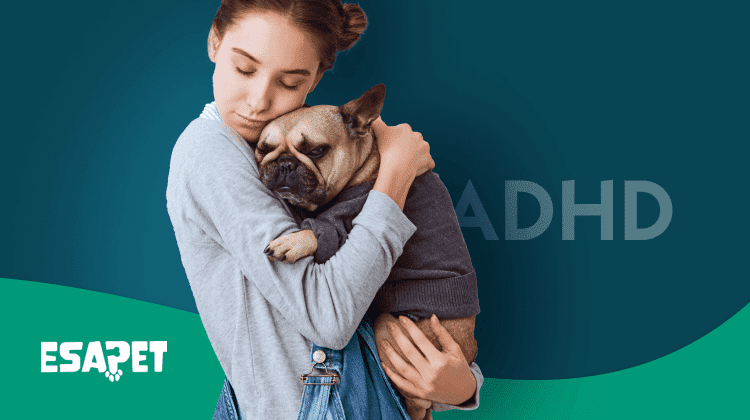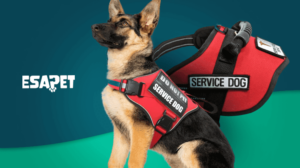Service Dog for ADHD and Its Life-Changing Impact

Service dogs play an essential role in assisting individuals with various disabilities. They provide both practical support and emotional comfort. For those with mental health conditions, such as ADHD, these dogs can be a lifeline.
Service dogs help manage specific symptoms, improve daily life, and offer a sense of stability that can be challenging to achieve. Living with ADHD can be tough, marked by inattention, hyperactivity, and impulsivity. These things make everyday tasks daunting and overwhelming.
In this guide, we’ll discuss the ADHD service dog. We will discuss how these dogs can benefit individuals, what tasks they can perform, and how to obtain one.
What is Attention Deficit Hyperactivity Disorder (ADHD)?
Attention Deficit Hyperactivity Disorder (ADHD) is a neurodevelopmental condition. Persistent patterns of difficulty paying attention, hyperactivity, and impulsivity characterize it. These things interfere with daily functioning or development.
Individuals with ADHD may find it challenging to focus on tasks, follow instructions, or stay organized. ADHD symptoms often manifest in childhood and can continue into adulthood. These symptoms affect academic, occupational, and social aspects of life.
The symptoms of ADHD can vary. Some individuals experience inattentive symptoms. However, others show hyperactive-impulsive behavior symptoms, and many exhibit a combination of both.
Service Dogs, ESAs, and Therapy Animals
Is important to understand the differences between Service Dogs, ESAs, and Therapy Animals. These differences help recognize their unique roles and benefits. Here’s a quick explanation of each:
Service Dog
A service dog is specially trained to perform tasks for an individual with a disability. These tasks are directly related to the person’s disability. These tasks include
- Guiding individuals who are blind
- Alerting those with hearing impairments
- Pulling a wheelchair
- Alerting and protecting a person having a seizure
Service animals undergo extensive training to meet the specific needs of their handlers. They have public access rights under the Americans with Disabilities Act (ADA).
Emotional Support Animal
An ESA provides comfort and support to individuals with mental disabilities. Unlike service dogs, ESAs do not need special training to carry out tasks. ESAs provide comfort for disabilities like:
- Anxiety
- Depression
- PTSD
- Bipolar Disease
- Panic Attack
Emotional support animals do not have the right to public access. However, they are often allowed in housing under the Federal Fair Housing Act (FHA). This law helps them provide therapeutic support to their owners.
Therapy Animal
Therapy animals, commonly dogs, are trained to offer affection and comfort to individuals. They offer comfort to individuals in hospitals, nursing homes, schools, and other environments. Therapy animals provide comfort for:
- Autism Spectrum Disorder (ASD)
- Post-Traumatic Stress Disorder (PTSD)
- Physical Disabilities
- Mental Health Disorders
- Alzheimer’s Disease and Dementia
- Chronic Illness and Pain
Unlike service dogs and ESAs, a therapy dog does not have individual handlers. Instead, they visit various facilities to offer emotional benefits to many people. These animals undergo training to ensure they can interact with diverse populations.
Psychiatric Service Dogs
A PSD is a type of service dog that assists individuals with mental health disabilities. These disabilities include:
- ADHD
- Bipolar Disorder
- Depression
- Anxiety
These dogs perform specific tasks that mitigate their handler’s psychiatric symptoms. For someone with ADHD, a PSD might help with organization, combat loneliness, or interrupt impulsive behaviors. For individuals with anxiety or bipolar disorder, a PSD can:
- Provide deep-pressure therapy
- Alert their handler to panic attacks
- Create a safe space around them in crowded areas
The tailored support these dogs offer can significantly improve the quality of life for those with mental conditions.
Emotional Support Dog vs. Psychiatric Service Dog
An ESD and a PSD both provide support to individuals with mental health conditions. However, they serve different roles and have distinct legal distinctions. Below, we will discuss the key differences between Emotional Support Animals Vs Service Animals:
- Purpose and Role: An ESD provides general emotional comfort and companionship. A PSD is trained to perform tasks that assist people with a psychiatric disability. important task. unconditional love. following benefits.
- Training Requirements: Emotional Support Dogs don’t need specialized training beyond basic obedience. Psychiatric Service Dogs undergo extensive and specific training to perform tasks.
- Legal Protections and Rights: The Fair Housing Act (FHA) allows them to live in housing that has a no-pets policy. The Americans with Disabilities Act (ADA) protects PSDs. It allows them access to public places where pets are typically not allowed.
- Documentation and Certification: An ESD requires a letter from a licensed professional. It should state the need for the animal due to a diagnosed condition. A PSD does not need specific documentation or certification required by law.
How Can a Service Dog Help with ADHD
Service dogs can be incredibly beneficial for individuals with ADHD. They provide both mental and physical support that helps manage symptoms. These animals assist with tasks, bringing stability to the lives of those with ADHD.
Mental Benefits
Enhanced Focus and Concentration:
Service dogs can help individuals stay on track. They provide gentle reminders to focus on their activities.
Reduced Anxiety:
These dogs can offer emotional grounding during moments of anxiety. The presence of a service dog helps to calm the mind.
Improved Routine:
Service dogs need a schedule. This can help individuals with ADHD establish and maintain a daily routine. Service dogs help in time management and organization.
Physical Benefits
Increased Physical Activity:
Service dogs encourage regular exercise. They do this through daily walks, playtime, and other activities. These exercises can help manage hyperactivity.
Health Monitoring:
You can train them to remind owners to take medication, drink water, or eat meals at regular intervals. This helps in promoting overall health and wellness.
Emergency Assistance:
In the event of a crisis, a service dog can provide immediate support. They can perform tasks like retrieving a phone or alerting others for help.
Overall, service dogs benefit individuals with ADHD. They enhance their quality of life and help them navigate daily challenges effectively. For more information on the benefits of service animals
|
Overall, service dogs benefit individuals with ADHD. They enhance their quality of life and help them navigate daily challenges effectively. For more information on the benefits of service animals. |
What Tasks Can an ADHD Service Dog Perform
ADHD service dogs can perform tasks tailored to the specific needs of their handlers. Some of the most common tasks include:
These tasks help manage ADHD symptoms. It allows individuals to feel more independent, confident, and calm.
How to Train a Service Dog for ADHD?
Training a service dog for ADHD involves several detailed steps. This helps ensure the dog can assist with tasks related to the handler’s symptoms. Here’s a detailed guide:
- Professional Assessment: Begin by obtaining a diagnosis of ADHD from a licensed professional.
- Selection of the Dog: Choose a dog with the right temperament and health for service work. Breeds commonly used for service dogs include Labradors, Golden Retrievers, and Poodles.
- Basic Obedience Training: Ensure the dog is well-trained in basic obedience commands. These commands can include sit, stay, come, and heel.
- Task-Specific Training: Train the dog to perform tasks to assist with ADHD symptoms. This training should be consistent and use positive reinforcement techniques.
- Public Access Training: Teach the dog to behave appropriately in various public settings. Ensure it remains calm and focused on its tasks.
- Certification and Registration: This is not legally required. However, some handlers choose to register their service dog with a reputable organization. It helps confirm its status as a service animal.
Do I Qualify for an ADHD Service Dog?
Qualifying for an ADHD service dog is a simple process. It involves several important steps:
- Diagnosis: Get a formal diagnosis of ADHD from a licensed mental health professional. This documentation is crucial for establishing the need for a service dog.
- Functional Limitations: Prove that ADHD impacts your daily life. Also, how a service dog can help mitigate these challenges.
- Commitment: Show a willingness and ability to care for a service dog. It includes time, financial resources, and the physical ability to manage the dog’s needs.
- Professional Evaluation: You should undergo an evaluation by a qualified service dog organization. This will help determine the suitability of a dog for your specific situation.
We know acquiring a Service Dog might be a long process. It also demands attention and continuous care. So, we brought you everything on the acquiring process and the overall costs of getting a support animal.
Which Dog Breeds Are Best for ADHD Service Dogs?
Choosing the right dog breed for an ADHD dog is crucial for providing effective support. Certain breeds possess the characteristics that make them particularly well-suited. Here are some breeds that are particularly well-suited for this role:
- Labrador Retrievers: Friendly and gentle nature. Labradors are highly trainable and excellent at performing various tasks.
- Golden Retrievers: Intelligent, affectionate, and easy to train. They excel in providing emotional support. They are often used in therapy settings due to their calming presence.
- German Shepherds: Loyal and protective nature. They are highly trainable and can perform complex tasks. This makes them suitable for handlers who need a high level of support.
- Border Collies: Known for their intelligence and excess energy. Border Collies are excellent for handlers who need help managing hyperactivity. Their ability to learn quickly makes them ideal for performing specific ADHD-related tasks.
How to Get a Service Dog for ADHD
Getting a service dog for ADHD involves a detailed, step-by-step process. Here are the steps that you need to follow:
- Obtain a Diagnosis: Start by obtaining an ADHD diagnosis from a licensed professional. This step is important to establish the need for a service dog.
- Determine Needs: Identify the specific tasks you need the service dog to perform to help manage your ADHD symptoms.
- Find a Training Program: Look for reputable service dog training programs or organizations. Some organizations offer pre-trained dogs, while others provide training for your dog.
- Training the Dog: If you already have a dog, begin training it in basic obedience. Then, move on to specific tasks that address your ADHD symptoms. Professional trainers can assist with this process.
- Certification: Obtaining certification from a reputable organization can help confirm the dog’s status. It helps ensure the service dog meets high training standards.
- Registering the Dog: Registration is optional. It can provide extra legitimacy and help in situations where your service dog’s status is questioned.
|
For more information on obtaining a psychiatric service dog letter, visit Psychiatric Service Dog Letter. |
Get Your Legit PSD Letter in 3 Easy Steps
Getting a PSD letter is an easy process. ESAPet streamlines this process in three easy steps:
Step 1: Quick Screening Process
Start by completing a brief initial screening to check your eligibility for a PSD Letter. This quick questionnaire gathers information about your disability. It assesses your service dog’s behavior and training.
Step 2: Consultation with a Mental Health Expert
Next, you’ll connect with a licensed mental health professional. This professional will test your disability and determine the suitability of a PSD for your needs.
During this telehealth session, you will discuss your disability in detail. You need to highlight how it affects your daily life and how your service dog assists you in managing these challenges.
Step 3: Receive Your PSD Letter
Once the professional confirms your eligibility, they will issue a signed PSD letter. You will receive your signed PSD letter online within three business days.
The process is straightforward and hassle-free. It ensures you get the documentation you need quickly and efficiently.
Get your Official PSD Letter Consultation from a licensed therapist.
Get PSD Letter Now
FAQs about ADHD Service Dog
Can Someone With ADHD Get a Service Dog?
Yes. Individuals with ADHD can qualify for a service dog. Their condition should impact their daily life.
Should Someone With ADHD Have a Dog?
Having a dog can be highly beneficial for ADHD patients. These dogs provide companionship, routine, and encouragement for physical activity. This helps manage symptoms efficiently.
What Does an ADHD Dog Do?
An ADHD dog gets trained to perform tasks like medication reminders, task transition alerts, and retrieving items. These tasks help the dog leave overstimulating environments and provide emotional grounding.
Is There a Dog Version of ADHD?
Dogs don’t have ADHD like humans. However, some may exhibit hyperactive or inattentive behaviors. This can be managed with proper training and care.
Conclusion
ADHD service dogs provide essential support for individuals with ADHD. They help manage symptoms, improve daily functioning, and offer emotional comfort. These trained animals perform various tasks tailored to the needs of their handlers.
Understanding the benefits, training requirements, and steps to getting a service dog is crucial. It helps you make an informed decision about this life-changing support. If you or someone you know struggles with ADHD, an ADHD service dog might be a valuable addition to your life.











